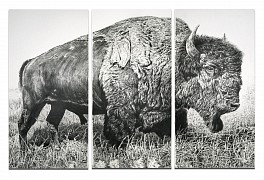BIOGRAPHY

Rick Shaefer grew up mostly in Europe and was introduced early on to the European landscapists—most notably to the Dutch and British painters like Ruisdael, van Huysum, Durer, Rembrandt (especially his etchings), and Constable and Turner. These still tend to be touchstones for his work.
His drawings lean toward a contrast and scale that feels entirely modern. The charcoal line work is kept pristine and the vocabulary gestural so that there is as much detail as possible without getting bogged down in the tedium of a photo-realist approach. The abundance of the marks leads the viewer to anticipate even more detail and fidelity than is there upon closer inspection. He has consciously tried to build into the drawings this interplay between the visceral calligraphic nature of the marks up close and the process by which they visually coalesce when stepping back.
The cloud paintings allow for a sensuous counterpoint to the line work of the drawings. In these he attempts to maintain a looseness of approach with the brush and paint allowing the medium to have a significant voice in the process. A foundation is laid down with large brushes and loose strokes followed by glazing. The intent is to approximate the ephemeral material of clouds and yet capture their often sturdy and imposing seeming bulk that can often take on a robust, sculptural presence.
"I tend to always come back to the line work. I find what I respond to and admire in other artists’ work, past or present, is usually the integrity of the line – whether it’s a single stroke or a mass of scribble in the shadows. If the marks are put down with validity and assurance they will resonate and the piece will vibrate. False or uneasy notes stand out and unsettle and even demoralize. A confident fluidity of movement and gesture is what is consciously and unconsciously felt and appreciated by the viewer. At least that is how I respond to a work.
"For me the scale of larger drawings compels a distinct approach to the process of the mark-making —more gestural, almost calligraphic. The act of drawing itself is a highly sensual and pleasurable one. If things are working I hurriedly scribble with a writer’s hand in a spontaneously invented language with looping cursive gestures, larger flourishes, and tight punctuations. If the rhythm is there you find yourself writing your way across the surface as if capturing thought in a frenzied rush of note taking.
"Because of my photography background and countless hours spent trying to secure a rich array of grays and blacks in the prints, creating a full range of tones in the black and white drawings is important. But for these larger pieces it has been crucial for me to create the tonal range by line alone – without smudging and rubbing the charcoal in any way. Maintaining the crispness of the individual marks is the goal—not unlike that of an etching, engraving or woodcut—with rich blacks being crucial to the conveyance of shape but also to the sense of bulk and weight.
"I have been drawn to subjects with a great variety of textural surfaces: the idea being to draw these pieces life size, with an archivist’s fidelity to detail and scale. In a sense, the process is not unlike scanning the surface of a highly varied landscape from high up—mapping the transitions from rough areas of exuberant detail to the occasional quiet patches. When I first decided to do this series, brought on by the felling of a large old oak in a neighbor’s field during a storm, the textures of the bark and decay were what initially caught my eye. Added to that was the sense of massive weight and the anthropomorphic elements in the curvature of the trunk and the large “eye” in the middle. It seemed to resemble a large dying beast, a beached whale for instance, peering at us from the finale of a grand and quickly waning life. The vast wealth of mythology, symbolism, and iconography surrounding our historical relationship with trees can’t help but inform such encounters. Presented in these drawings life-size and complete, these large trees take on an almost totemic presence -- quietly insistent on our engagement with them.
"The surface and scale exploration of the first oak tree led to the Rhino, with its similar beseeching eye and intricately distinctive, textured hide. Subsequent works in this series continue to explore the extensive use of line work to convey a perception of an abundance of detail and a sense of voluminous weight while keeping the mark making itself fluid and almost abstract when viewed up close."
-Rick Shaefer
